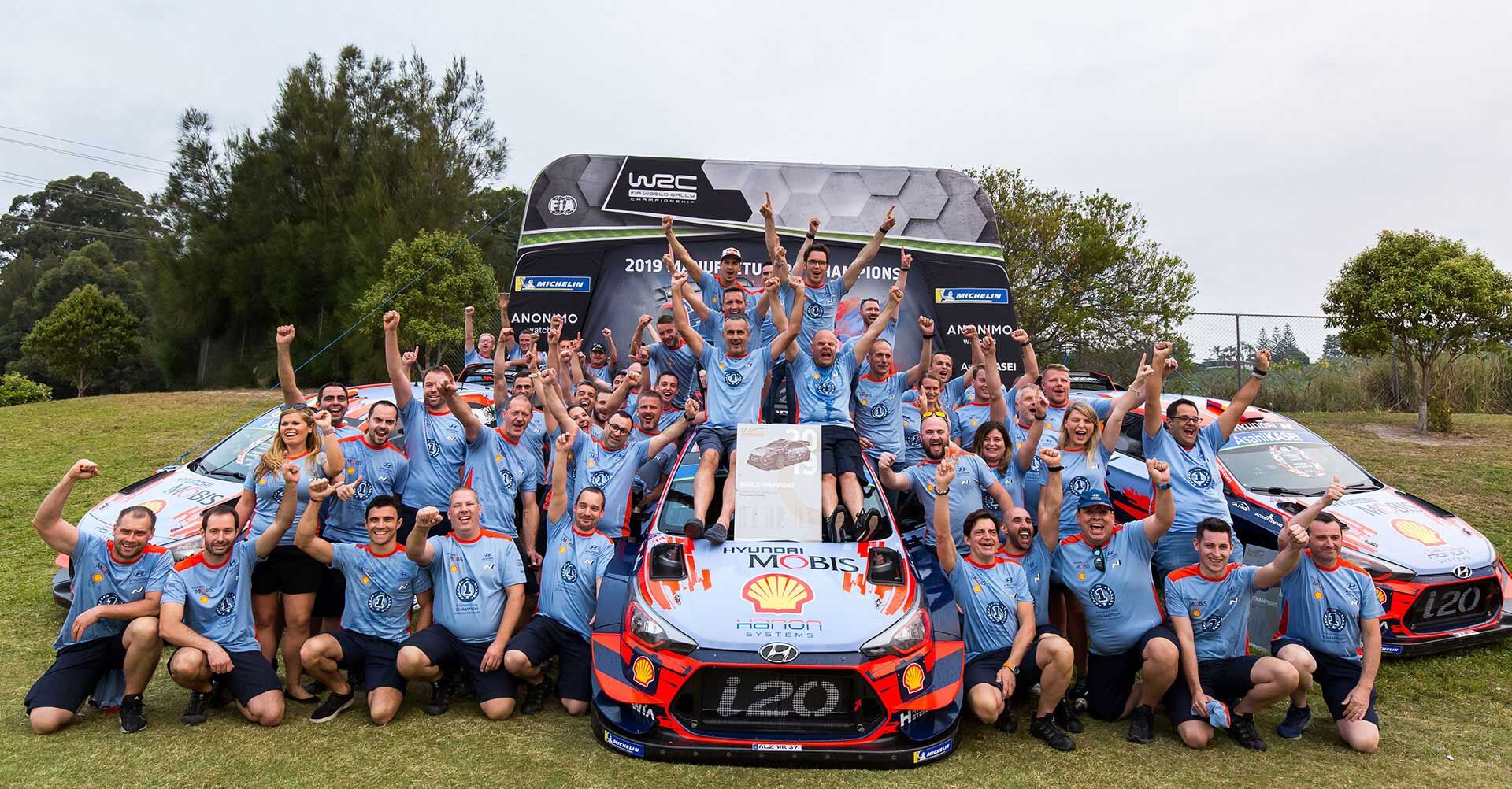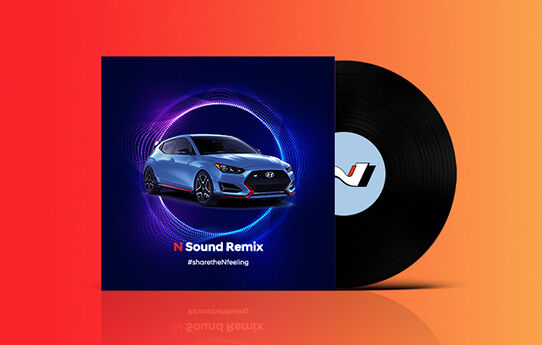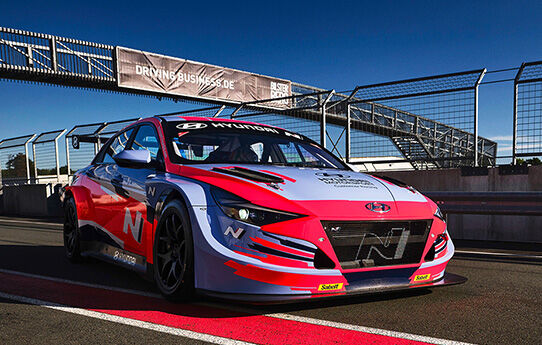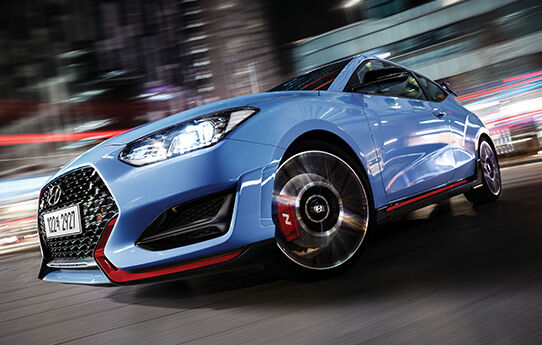Hyundai’s rally heritage.
03 Dec 2020
Hyundai’s maiden World Rally Championship (WRC) title in 2019 was a landmark moment. It was the first time that a Korean manufacturer had scooped the title, but it also marked the realization of a long-held dream.
The current Hyundai Motorsport organization was set up in the German town of Alzenau, near Frankfurt, in December 2012. It was the beginning of a brand new chapter that would lead the company to the top prize in international rallying, but the roots of the story stretch back even further.
03 Dec 2020

Early days
(1991–1999)
One of the first drivers to compete in major events with a Hyundai was Australian rally legend Wayne Bell. In 1991, he began using a Hyundai Lantra for regional rallies in Australia and South East Asia, picking up class wins almost from the word go. From 1993, he received works backing to compete in the Asia Pacific Rally Championship (APRC), but Bell had his eye on an even bigger prize.
Success in the regional events had encouraged Hyundai to enter a pair of F2 cars into the 2-litre World Rally Cup (the equivalent of today’s WRC-2 category, in which the Hyundai i20 R5 now competes). The plan was to use this series as an intermediate step, before progressing to the WRC.
British firm Motor Sports Developments was brought in to run the cars, effectively merging with Bell’s Australian team in the process and creating the Hyundai Coupé Kit Car.
This curvaceous little coupé was a development of the car that Bell had campaigned in the APRC the year before. It featured an immensely strong chassis and a torquey long-stroke engine that gave it excellent traction on gravel events. It made its 2-litre World Rally Cup debut in Portugal in March 1998, with Bell finishing fourth in class, while teammate Kenneth Eriksson put in a strong performance before retirement cut short his rally. From the next round, Alister McRae also joined the team.
Hyundai continued in the F2 class in 1999 with former touring car boss Paul Risbridger appointed as team manager. That year, Hyundai won the 2-litre class of the APRC and came within a hair’s breadth of winning the 2-litre World Rally Cup – finishing just seven points behind the far more experienced Renault team.
It’s easy to look back on F2 as a stepping stone to the WRC, but that car had real presence, It took lots of class wins.
I remember running two cars in China – effectively Hyundai’s home event at the time – and we came first and second. It was a very strong start for us.

First foray into the WRC
(2000-2003)
One of the reasons that Hyundai had chosen to compete in the F2 championship was that it visited the same events as the WRC. This meant that much of the infrastructure could be put in place before the World Championship campaign commenced. Nonetheless, it was a steep learning curve for the young team.
We designed and built the first WRC car in less than eight months while doing 10 rounds of the 2-litre World Rally Cup. By that point we were already used to running the team, but the technology on the WRC car was still a huge step up from F2, World Championship rallying is probably the most complex motorsport in the world. In circuit racing you build one car that does the same thing every week; in rallying you effectively have to build three cars – one for gravel, one for tarmac and one for snow. There are also quite fundamental differences even between what works well on a fast, smooth gravel stage and what works well on a rougher, slower gravel stage.
It’s a huge engineering challenge.
We designed and built the first WRC car in less than eight months while doing 10 rounds of the 2-litre World Rally Cup. By that point we were already used to running the team, but the technology on the WRC car was still a huge step up from F2, World Championship rallying is probably the most complex motorsport in the world. In circuit racing you build one car that does the same thing every week; in rallying you effectively have to build three cars – one for gravel, one for tarmac and one for snow. There are also quite fundamental differences even between what works well on a fast, smooth gravel stage and what works well on a rougher, slower gravel stage.
It’s a huge engineering challenge.
There was a real buzz to the team when the new Hyundai Accent WRC made its debut at the Swedish Rally in February 2000, he recalls: “We put in a huge amount of work to get the cars to Sweden. There were three all-night sessions before the event to ensure everything was ready. Both cars finished, which was our main target for that first event. It was really satisfying to see the car that we’d created from scratch out there in action.”
Eriksson and McRae remained the team’s principal drivers for 2000 and 2001, replaced by Armin Schwarz and Freddy Loix in 2002. This was to be the Accent’s most successful year in the WRC, with the team finishing fourth in the manufacturers’ standings, ahead of Skoda and Mitsubishi. Hyundai withdrew from the championship in 2003, but this period had successfully introduced the company to international-level motorsport and laid the foundations for what was to come.

A new beginning
(2012-2014)

When the current Hyundai Motorsport division was founded in 2012, it represented a whole new beginning. By June 2013, the team had moved into a brand new 8,200 square meter facility and employed a dedicated team of 50 in-house professionals from 11 different countries, with the headcount soon growing to more than 120. Michael Nandan – a hugely experienced WRC manager with three manufacturers’ titles to his name in the early 2000s – was brought in as the team principal.
When the current Hyundai Motorsport division was founded in 2012, it represented a whole new beginning. By June 2013, the team had moved into a brand new 8,200 square meter facility and employed a dedicated team of 50 in-house professionals from 11 different countries, with the headcount soon growing to more than 120. Michael Nandan – a hugely experienced WRC manager with three manufacturers’ titles to his name in the early 2000s – was brought in as the team principal.
The first job was to develop Hyundai’s all-new WRC car. Designed and tested in secret, the i20 WRC was a collaboration between Hyundai Motorsport in Alzenau and the Namyang R&D center in South Korea. Finnish driver Juho Hänninen was brought in for the first shakedown test, carried out on a disused airfield in France. Frenchman Bryan Bouffier and Australian Chris Atkinson later joined the test program, clocking up thousands of kilometers of running under a wide range of different conditions.
The i20 WRC was officially revealed at Hyundai’s European headquarters in Offenbach on 10th December 2013. It was a momentous day for the brand. Alongside the launch of the rally program, it was announced that the ‘N’ designation would be applied to all the company’s high performance activities, both in motorsport and future road car projects. In many respects, it marked Hyundai’s arrival as a truly sporting brand.

Young Belgian star Thierry Neuville headed up the driver line up for 2014 with co-driver Nicolas Gilsoul, alongside the versatile Spanish pairing of Dani Sordo and Marc Marti. Hänninen, Bouffier and Atkinson would all compete for the team at selected rounds (with co-drivers Tomi Tuominen, Xavier Panseri and Stéphane Prévot respectively). Shortly afterwards, young New Zealander Hayden Paddon and his hugely experienced co-driver John Kennard would be confirmed as the final crew for that year.
Neuville and Sordo were picked to be the drivers for the newly created team’s first event at Monte Carlo in January of that year. Both retired, but the car’s performance had been encouraging, with Sordo setting the second-fastest time on stage 4. Things improved rapidly from there, with a podium for Neuville in Mexico, followed by an historic 1-2 victory in Germany. The new Hyundai Shell World Rally Team finished a respectable fourth (out of eight) in the manufacturers’ standings in its debut season.

Building results
(2015–2018)

With Hyundai established as a genuine contender in the WRC, the hunt was on for the brand’s first world championship title. Atkinson, Hänninen and Bouffier stepped back, while Dutchman Kevin Abbring was drafted in for selected events in 2015, with co-driver Marshall Sebastian. Highlights included podiums in Sweden, Sardinia and Spain. Meanwhile, behind closed doors, the New Generation i20 WRC was starting to take shape in preparation for 2016.
The new car switched to the five-door i20 as its base (in place of the three-door model used previously) and boasted improved weight distribution and enhanced aerodynamics. Neuville drove the car to third on its first event in Monte Carlo – one of 12 podiums in 2016, along with two wins and no less than 47 stage victories. Hyundai’s reward was second in the manufacturers’ championship, while Neuville was the runner up in the drivers’ standings.

The following year heralded a new era in the WRC. A fresh set of technical regulations brought more power, less weight and significantly more freedom in the aerodynamic design of the cars. It was likened to the glory days of Group B, with the cars promising to be the fastest and most dramatic WRC machines in years.
Hyundai was right in the mix once again with the new i20 Coupe WRC. Neuville came second in the drivers’ championship, having led for significant parts of the season, with the team second in the manufacturers’ standings.
The following year heralded a new era in the WRC. A fresh set of technical regulations brought more power, less weight and significantly more freedom in the aerodynamic design of the cars. It was likened to the glory days of Group B, with the cars promising to be the fastest and most dramatic WRC machines in years.
Hyundai was right in the mix once again with the new i20 Coupe WRC. Neuville came second in the drivers’ championship, having led for significant parts of the season, with the team second in the manufacturers’ standings.
It was a similar story in 2018, with Neuville once again leading the championship for most of the year, only for bad luck to intervene in the closing stages. He went into the final round in Australia just three points behind the championship leader and with a very real chance of clinching the title. Unfortunately, a puncture on the first day dropped him down the order. He then managed to work his way back up the leaderboard, only to clip a tree near the end of the final day and retire. Nonetheless, it was Hyundai’s best year yet, finishing a handful of points behind the leaders in both the drivers’ and manufacturers’ championships. The title was now close. Tantalizingly close.

An historic victory
(2019)

At the start of the 2019 season, current team director Andrea Adamo took over from longstanding principal Nandan. Formerly head of Hyundai Motorsport’s customer program, and with a background in LMP prototypes and touring cars prior to that, the 47-year old Italian brought a renewed hunger to the team. There was also exciting news elsewhere in the line up, with the most successful driver in WRC history, Sebastian Loeb, joining the team for six rounds of the championship along with co-driver Daniel Elena.
At the start of the 2019 season, current team director Andrea Adamo took over from longstanding principal Nandan. Formerly head of Hyundai Motorsport’s customer program, and with a background in LMP prototypes and touring cars prior to that, the 47-year old Italian brought a renewed hunger to the team. There was also exciting news elsewhere in the line up, with the most successful driver in WRC history, Sebastian Loeb, joining the team for six rounds of the championship along with co-driver Daniel Elena.

The year started well, with podium finishes for Neuville in Monte Carlo and Sweden. Back-to-back victories in Corsica and Argentina put the Belgian on top of the leaderboard, before a huge accident in Chile saw him retire from the event and drop to third in the title chase. Meanwhile, strong performances by Dani Sordo and Andreas Mikkelsen helped to maintain a small lead in the manufacturers’ championship.
It was all to play for as the teams headed to what would become the final round of the 2019 season in Catalunya. Neuville found himself in a tense battle with Ott Tänak that raged through to the final stage. In the end, it was the Hyundai driver who came out on top, snatching second in the drivers’ championship in the process. Sordo continued his run of good form, finishing third. But the biggest celebration was reserved for the team itself. Hyundai had extended its lead in the manufacturers’ championship in Catalunya, and with the cancellation of the planned finale in Australia, the South Korean constructor took its first ever WRC title.
It was the peak of a job that was started many years ago, Finally everything fell into place and we got the title that the team had already been fighting to capture for years before. It was a very special moment.



The future
(2020)

Looking back, Adamo says a number of other moments stand out in his career so far with the team: “The first win after I took over, in Corsica last year, was very special for me. And then coming back at the beginning of this year as the manufacturers’ champions and winning in Monte Carlo was a really good feeling.”
The 2020 season has been perhaps the strangest in the WRC’s 47-year history, but Hyundai has been fighting hard to add to its trophy cabinet. “Of course, the target is still to win both titles this year,” comments Adamo. “It’s been a very unusual season. We had the first three rallies, then lockdown, followed by a new rally style with a very different way of traveling and organizing the events. It’s been a real challenge.”

Despite the challenging situation, he already has one eye on 2021: “First of all, I hope that rallying returns to normal next year. Organizing everything these days is quite tricky. Our engineers are working on developing the car even further so I hope that we will be even more competitive next year.”
With its first WRC title in 2019, Hyundai captured what is arguably the most demanding title in international motorsport. It was the product of many years of hard work, determination and technological innovation. But the story has only just begun.
Despite the challenging situation, he already has one eye on 2021: “First of all, I hope that rallying returns to normal next year. Organizing everything these days is quite tricky. Our engineers are working on developing the car even further so I hope that we will be even more competitive next year.”
With its first WRC title in 2019, Hyundai captured what is arguably the most demanding title in international motorsport. It was the product of many years of hard work, determination and technological innovation. But the story has only just begun.





